
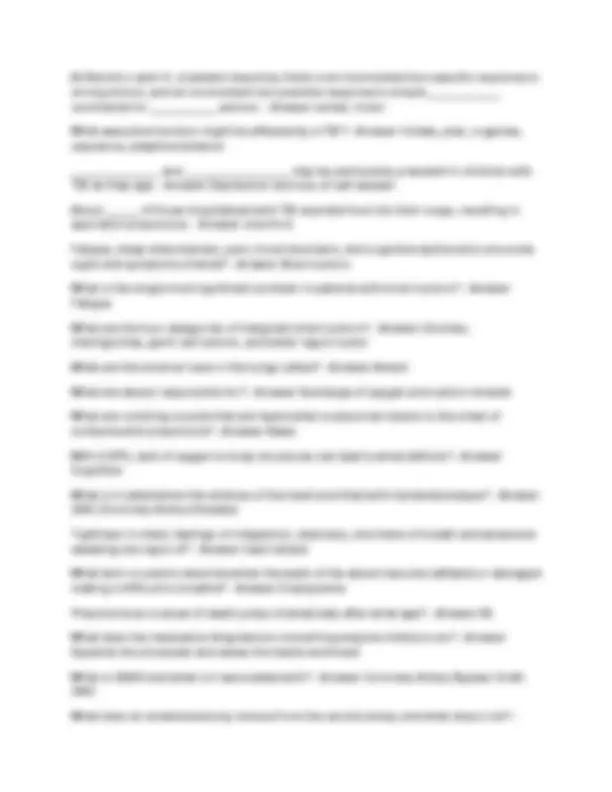
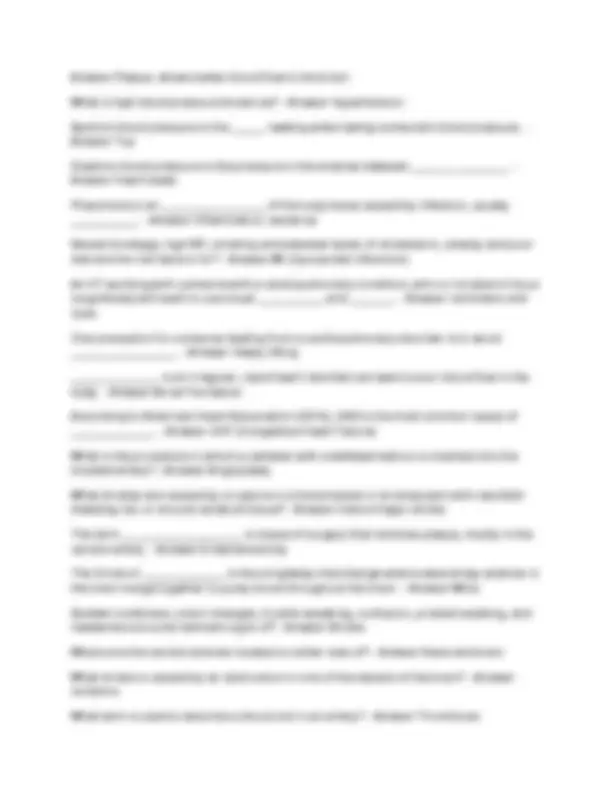
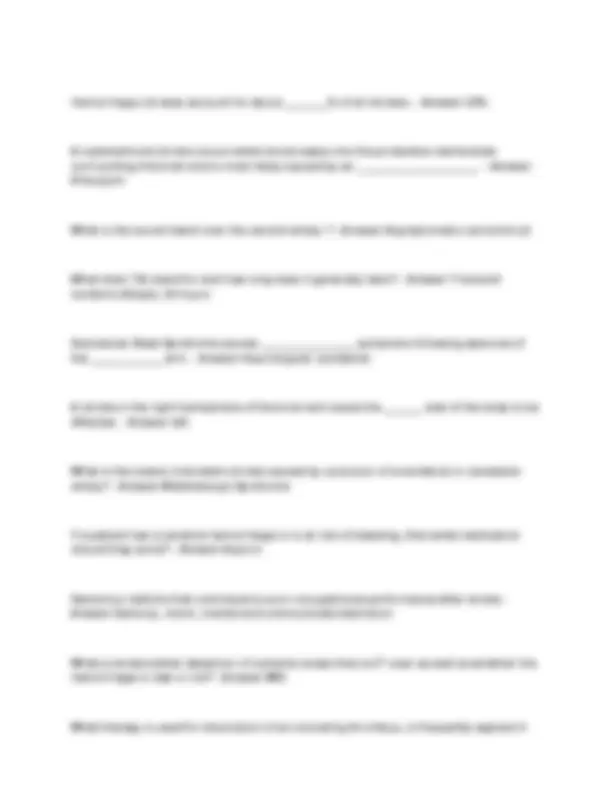
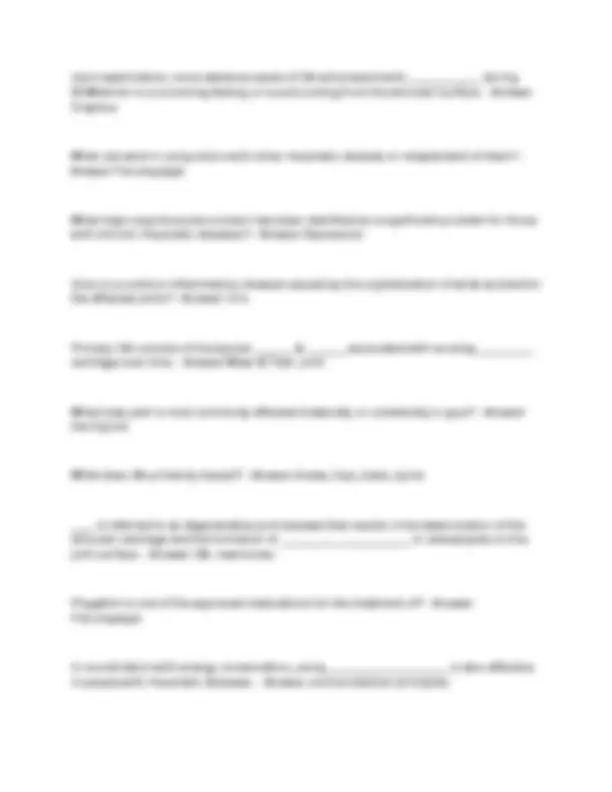
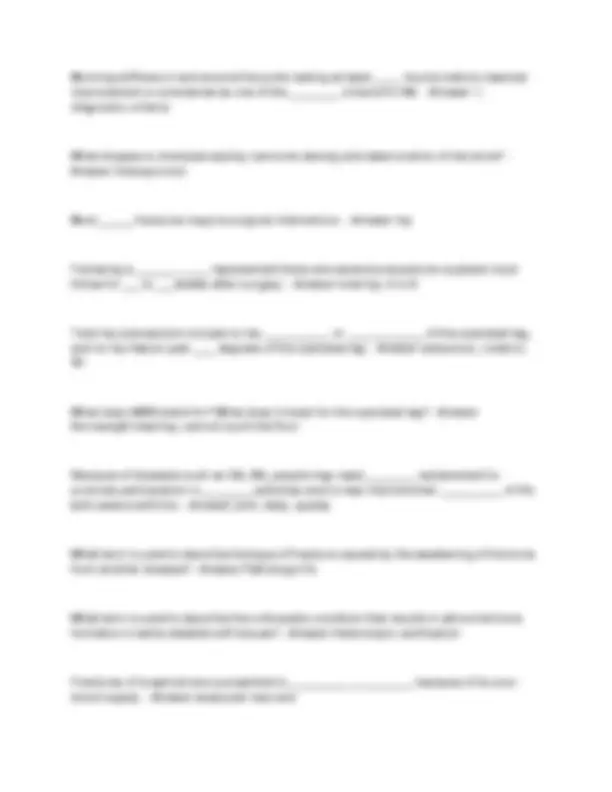

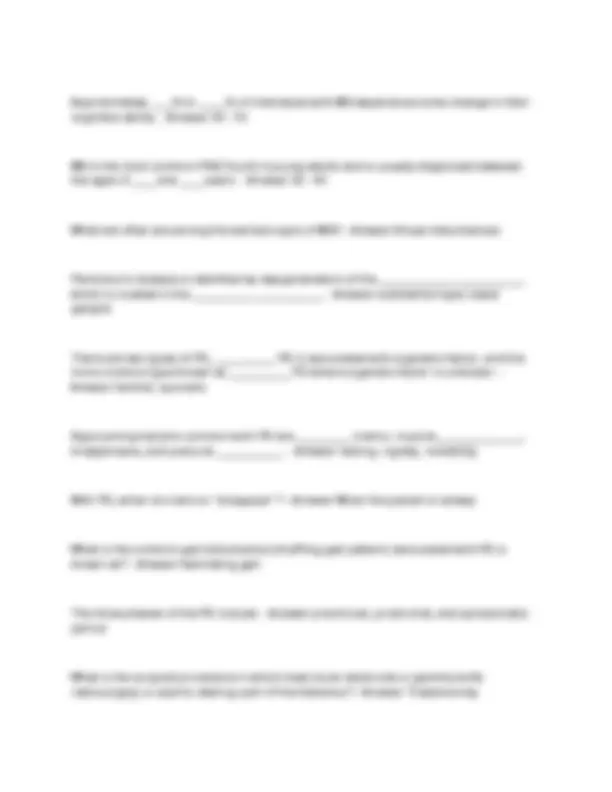
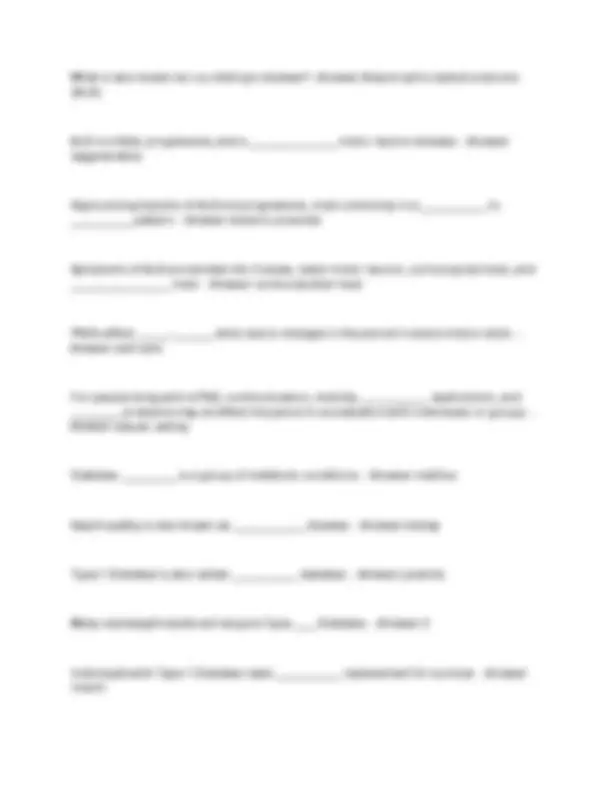
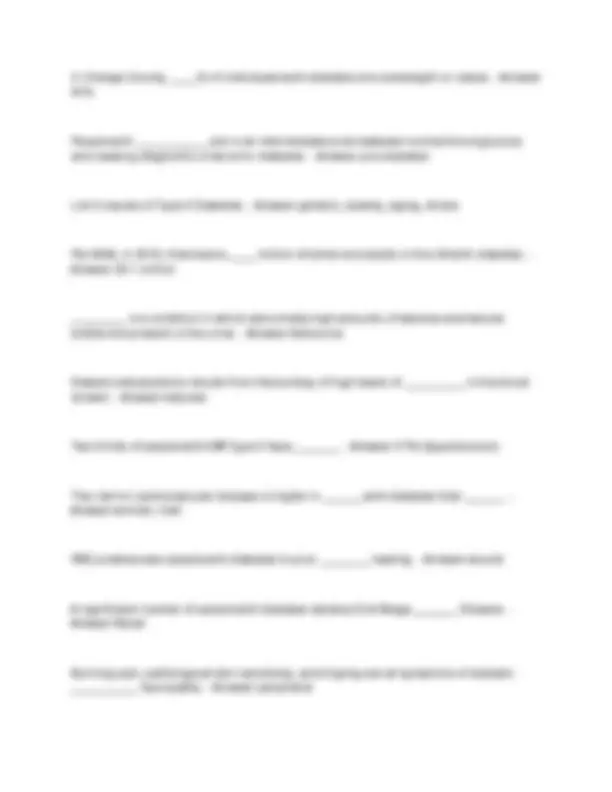


Study with the several resources on Docsity

Earn points by helping other students or get them with a premium plan


Prepare for your exams
Study with the several resources on Docsity

Earn points to download
Earn points by helping other students or get them with a premium plan
Community
Ask the community for help and clear up your study doubts
Discover the best universities in your country according to Docsity users
Free resources
Download our free guides on studying techniques, anxiety management strategies, and thesis advice from Docsity tutors
OT 5012 Clinical Conditions - Final Exam Study Set
Typology: Exams
1 / 16

This page cannot be seen from the preview
Don't miss anything!










What is the largest organ in the body? - Answer SKIN
What is nonvascular and the thin outer layer of skin called? - Answer EPIDERMIS
The bulk of the skin is made up of the ________________. - Answer DERMIS
Where are hair follicles, blood vessels, sweat glands, nerve endings, and sebaceous glands found? - Answer DERMIS
What vitamin does skin produce? - Answer Vitamin D
What does the skin control? - Answer Body Temperature
What are the two primary factors that influence the amount of tissue destruction that occurs following a burn are? - Answer Temperature and duration of exposure
What does a full thickness burn destroy? - Answer Epidermis, dermis, and subcutaneous fat
What is TBSA stand for? - Answer Total Body Surface Area
What rule is used at accident sites to describe the extent of a burn? - Answer Rule of 9's
1/3 of burn injuries in the U.S. are from? - Answer Children
What products are released during combustion, causing pulmonary complications in burn victims? - Answer Carbon Monoxide
What is the term used to describe dead skin tissue associated with burns and other wounds? - Answer ESCHAR
What basic structural fibrous protein causes a thickening of a burn scar? - Answer Collagen
What is the criteria for a burn center referral include? - Answer Partial thickness burns > 10% TBSA
Persons in an __________________ fire are at greater risk for development of pulmonary complications. - Answer Enclosed
Burn shock is a ________________ complication where there is a marked ________________ in peripheral vascular resistance with a ________________ in cardiac output. - Answer Cardiac;
Increase;
Decrease
What is the treatment used for burn shock? - Answer Fluid Resuscitation
What is Fluid Resuscitation? - Answer Administration of intravenous fluid
What term is used to describe the breakdown of complex molecules into simpler ones for energy release? - Answer Catabolism
What term is used to describe the cleansing and removal of non-adherent and nonviable tissue? - Answer Debridement
What is it called when burned skin is covered by donor skin taken from another person?
A cultured epithelium graft is fragile and susceptible to ______________. - Answer infection
What garments help control hypertrophic scars? - Answer Compression
What kind of movements can create TBI's? - Answer Acceleration, deceleration, rotation or intrusion
What sensitive part of the brain is often damaged in TBI? - Answer Parasagittal White Matter
Hyperventilation, hormonal changes and electrolyte disturbances are components of? - Answer TBI
Who are most at risk for TBIs? - Answer Young men between the ages of 15 - 24
What are the three leading causes of TBI's? - Answer Falls, MVA, and violence
What are one of the signs of TBI? - Answer A depressed level of consciousness
What is defined as an extensor posture of all limbs and/or trunk? - Answer Decerebrate rigidity
Decorticate rigidity (with flexion of the upper and extension of the lower limbs) is present when the brainstem is ______________, despite severe cortical damage. - Answer Intact
What do abnormal reflexes do to movement patterns? - Answer Complicate
What is common in adults with moderate to severe TBI? - Answer Spasticity
What does LCFS or Rancho Los Amigos Level I represent? - Answer A period of dense unresponsiveness to all external stimuli
At Rancho Level _____ is the confused, inappropriate, non-agitated level where frequent redirection is needed for any task completion? - Answer V (five)
Answer Plaque; allows better blood flow to the brain
What is high blood pressure known as? - Answer Hypertension
Systolic blood pressure is the ______ reading when taking someone's blood pressure. - Answer Top
Diastolic blood pressure is the pressure in the arteries between ________ _________. - Answer Heart beats
Pneumonia is an ___________________ of the lung tissue caused by infection, usually ____________. - Answer Inflammation; bacterial
Vessel blockage, high BP, smoking and elevated levels of cholesterol, obesity and poor diet are the risk factors for? - Answer MI (myocardial infarction)
An OT working with someone with a cardiopulmonary condition, who is not able to focus (cognitively) will want to use visual ____________ and ________. - Answer reminders and cues
One precaution for someone healing from a cardiopulmonary disorder is to avoid ___________________. - Answer Heavy lifting
________________ is an irregular, rapid heart rate that can lead to poor blood flow in the body. - Answer Atrial Fibrillation
According to American Heart Association (2014), CAD is the most common cause of _______________. - Answer CHF (Congestive Heart Failure)
What is the procedure in which a catheter with a deflated balloon is inserted into the blocked artery? - Answer Angioplasty
What strokes are caused by a rupture in a blood vessel or an aneurysm with resultant bleeding into or around cerebral tissue? - Answer Hemorrhagic stroke
The term ______________________ is a type of surgery that removes plaque, mostly in the carotid artery. - Answer Endarterectomy
The Circle of _______________ is like a highway interchange where several key arteries in the brain merge together to pump blood throughout the brain. - Answer Willis
Sudden numbness, vision changes, trouble speaking, confusion, problem walking, and headache are some hallmark signs of? - Answer Stroke
Where are the carotid arteries located on either side of? - Answer Neck and brain
What stroke is caused by an obstruction in one of the vessels of the brain? - Answer Ischemic
What term is used to describe a blood clot in an artery? - Answer Thrombosis
Hemorrhagic strokes account for about ________% of all strokes. - Answer 20%
A subarachnoid stroke occurs when blood seeps into the protective membranes surrounding the brain and is most likely caused by an ______________________. - Answer Aneurysm
What is the sound heard over the carotid artery.? - Answer Asymptomatic carotid bruit
What does TIA stand for and how long does it generally lasts? - Answer Transient Ischemic Attack; 24 hours
Subclavian Steal Syndrome causes _________________ symptoms following exercise of the _____________ arm. - Answer Neurological; ipsilateral
A stroke in the right hemisphere of the brain will cause the _______ side of the body to be affected. - Answer left
What is the classic brainstem stroke caused by occlusion of a vertebral or cerebellar artery? - Answer Wallenberg's Syndrome
If a patient has a cerebral hemorrhage or is at risk of bleeding, then what medication should they avoid? - Answer Aspirin
Name four deficits that contribute to poor occupational performance after stroke - Answer Sensory, motor, mental and communication/emotion
What provides better detection of ischemic areas than a CT scan as well as whether the hemorrhage is new or old? - Answer MRI
What therapy is used for dissolution of an occluding thrombus, is frequently applied in
serious
RA most often begins between ages _____ and _____ - Answer 25 and 50
What are the four stages of the inflammatory process? - Answer Acute, sub-acute, chronic active and chronic inactive
What is formed from the synovial membrane, which is a substance that causes the soft tissue destruction? - Answer Pannus
What extremities are by far the most severely affected by RA? - Answer Hands
What is frequent response in those with RA and JRA? - Answer Joint guarding or self-bracing
In order to consider JRA, the onset must occur before the age _____, with involvement of one or more joints for at least ____ weeks. - Answer Before the age of 16; 6
What are characteristic signs of RA at the wrist? - Answer Ulnar deviation and volar subluxation at the MCP joints or radial deviation
What results when the central slip of the extensor tendon erodes from its attachment on the middle phalanx? - Answer Boutonniere Deformity
In swan-neck deformity, the PIP joint goes in hyperextension and the DIP moves into flexion due to elongation of __________ of the PIP joint? - Answer Volar Plate
As RA progresses untreated, individuals may develop an abnormal gait pattern resulting from? - Answer Hip involvement
Upon examination, more advance cases of OA will present with _____________ during ROM which is a crunching feeling or sound coming from the articular surface. - Answer Crepitus
What can exist in conjunction with other rheumatic disease or independent of them? - Answer Fibromyalgia
What major psychosocial concern has been identified as a significant problem for those with chronic rheumatic diseases? - Answer Depression
Gout is a common inflammatory disease caused by the crystallization of what acid within the affected joints? - Answer Uric
Primary OA consists of the typical _______ & _______ associated with eroding __________ cartilage over time. - Answer Wear & Tear; joint
What body part is most commonly affected bilaterally or unilaterally in gout? - Answer the big toe
What does OA primarily impact? - Answer knees, hips, back, spine
____ is referred to as degenerative joint disease that results in the deterioration of the articular cartilage and the formation of __________ _____________ or osteophytes on the joint surface. - Answer OA; new bones
Pregablin is one of the approved medications for the treatment of? - Answer Fibromyalgia
In coordination with energy conservation, using ______________________ is also effective in people with rheumatic diseases. - Answer Joint protection principles
What is the final stage of fracture healing called? It occurs between ____ weeks and ___ year. - Answer Remodeling or consolidation; 6 weeks - 1 year
During the initial evaluation, it is important to assess the _____________ and ___________ surrounding the onset of orthopedic conditions. - Answer nature and circumstances
Two basic types of nerve tissues that make up the spinal cord include: - Answer Grey matter & white matter
Ascending afferent (sensory) pathways that carry pain & temperature sensations from the spinal cord up to the areas in the brain are ______________ tracts. - Answer lateral spinothalamic tracts
The leading cause of SCI in the United States is ______ , followed by ______ and acts of ___________. - Answer MVA; falls; violence
What syndrome occurs when only one side of the spinal cord is damaged? - Answer Brown Sequard Syndrome
_________ do not involve damage to the spinal cord itself, but rather to the spinal nerves that extend below the end of the spinal cord. - Answer Cauda equina injuries
What is the period of altered reflex activity immediately after a traumatic SCI is known as? - Answer spinal shocks
When a SCI patient suddenly starts sweating with goose bumps, flushing, pounding headache, tachycardia this may be due to? - Answer Autonomic dysreflexia
The application of external pressure on the abdomen with the fists, starting at the umbilicus, and pressing downward in order to force the urine from a LMN bladder due to SCI is called? - Answer Crede's maneuver
A person with a _____ SCI injury level may be able to drive with specially adapted steering, braking and acceleration and controls, and due to transfer limitations would drive directly from the wheelchair. - Answer C
A person at _____ SCI injury level generally would be able to wean from the ventilator but has continued difficulty with productive coughing and deep breathing. - Answer C
A person at _____ SCI injury level is generally independent with positioning, bed mobility, hygiene, feeding, shaving, hair care, dressing, bathing, cooking, and light housekeeping. - Answer C7-C
A person at ____ SCI injury level is generally independent with bowel/bladder care using adaptive equipment and techniques. - Answer C7-C
With a LMN bladder injury, a reflexive emptying of the bladder cannot occur as the _____________ is destroyed. - Answer Reflex arc
If the damage to the spinal cord does not cause a total transection, there will be some degree of movement or sensation below the level of injury. This is called: - Answer An incomplete injury
What are the three basic tumor cell types? - Answer Benign, in situ, malignant
What is a malignant tumor that originates in the plasma cells of bone marrow? - Answer Myeloma
What are cancerous tumors that arise in supportive and connective tissues including bones, tendons, cartilage, muscle, and fat? - Answer Sarcomas
What arise from and affect the blood, bone marrow, and the lymphatic system and include leukemia, lymphoma, and myeloma? - Answer liquid tumors
Approximately ____% to _____% of individuals with MS experience some change in their cognitive ability. - Answer 40 - 70
MS is the most common PND found in young adults and is usually diagnosed between the ages of ____ and ____ years. - Answer 20 - 40
What are often are among the earliest signs of MS? - Answer Visual disturbances
Parkinson's disease is identified by depigmentation of the ______________ ____________ which is located in the ___________ ____________. - Answer substantia nigra; basal ganglia
There are two types of PD, ___________ PD is associated with a genetic factor, and the more common type known as ___________ PD where a genetic factor is unknown. - Answer familial; sporadic
Signs and symptoms common with PD are __________ tremor, muscle _______________, bradykinesia, and postural ____________. - Answer resting; rigidity; instability
With PD, when do tremors "disappear"? - Answer When the patient is asleep
What is the common gait disturbance (shuffling gait pattern) associated with PD is known as? - Answer festinating gait
The three phases of the PD include: - Answer preclinical, prodromal, and symptomatic period
What is the surgical procedure in which heat via an electrode or gamma-knife radiosurgery is used to destroy part of the thalamus? - Answer Thalamotomy
What is also known as Lou Gehrig's disease? - Answer Amyotrophic lateral sclerosis (ALS)
ALS is a fatal, progressive, and a ________________ motor neuron disease. - Answer degenerative
Signs and symptoms of ALS are progressive, most commonly in a ____________ to ___________ pattern. - Answer distal to proximal
Symptoms of ALS are divided into 3 areas, lower motor neuron, corticospinal tract, and __________________ tract. - Answer corticoubulbar tract
PNDs affect ______-_______ skills due to changes in the person's sensorimotor skills. - Answer self-care
For people living with a PND, communication, mobility, ____________ dysfunction, and _________ problems may all affect the person's socialization with individuals or groups. - Answer sexual; eating
Diabetes __________ is a group of metabolic conditions. - Answer mellitus
Nephropathy is also known as _____________ disease. - Answer kidney
Type 1 Diabetes is also called ____________ diabetes. - Answer juvenile
Many overweight adults will acquire Type ____ Diabetes. - Answer 2
Individuals with Type 1 Diabetes need ____________ replacement for survival. - Answer insulin
What does DAN stand for? - Answer Diabetic Autonomic Neuropathy
If an individual has a "diabetic foot", you will find ________ on the foot. - Answer ulcers
People with diabetes often have ____________ disease because the mechanism that destroys bacteria in the mouth is inhibited by the disease. - Answer periodontal
_________ of the family is key to managing diabetes. - Answer Education
What is a chronic complication of diabetes? - Answer Slower mental speed